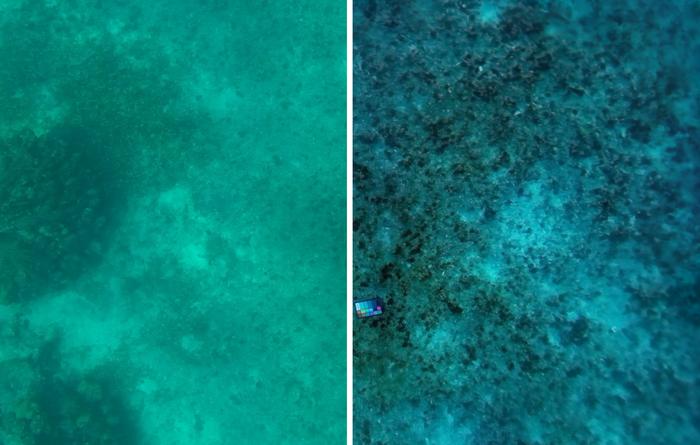Beneath the ocean’s surface, light behaves in baffling ways, distorting and diminishing the true colors of the vibrant life and landscapes hidden beneath the waves. Water absorbs and scatters light differently than air, with shorter wavelengths such as blue traveling farther than longer wavelengths like red. Additionally, particles suspended in the water create backscatter, a haze that further veils the underwater environment. This complex interplay of light and matter has long challenged researchers aiming to capture faithful visual representations of marine scenes, limiting our ability to study and appreciate underwater ecosystems remotely.
Now, a pioneering team of scientists from MIT and the Woods Hole Oceanographic Institution (WHOI) has introduced a groundbreaking computational tool, dubbed SeaSplat, that pierces through these aquatic optical barriers. This technology enables the reconstruction of underwater scenes in vivid true color, virtually removing the distorting effects of water and particles. Coupled with advanced 3D Gaussian splatting techniques, SeaSplat not only corrects individual images but also stitches them into immersive three-dimensional models. These models can be explored from any angle and distance, providing an unprecedented window into underwater worlds.
The genesis of SeaSplat lies in its ability to explicitly model how water affects light in underwater environments. Traditional imaging tools falter because they generally assume uniform color and brightness irrespective of viewing angle and distance, assumptions valid in air but invalid under water. By contrast, SeaSplat’s algorithm accounts for the physics of light attenuation and backscatter, recognizing that the appearance of objects varies dramatically with perspective and the inherent properties of the water column.
At its core, SeaSplat employs a physically grounded image formation model to quantify how each pixel in an underwater image is influenced by the surrounding water and particulate matter. It calculates the extent to which light has been scattered and absorbed, then mathematically reverses these effects to recover the pixel’s original color. This pixel-wise correction is integrated within a 3D Gaussian splatting framework—a method that represents scenes as collections of elliptical Gaussian “splats” that collectively render smooth, continuous, and realistic volumetric images.
3D Gaussian splatting itself is a breakthrough in computer vision and graphics. Unlike traditional polygonal mesh-based models, this technique leverages density functions to generate photo-realistic renderings that adapt fluidly to changes in viewpoint. However, before SeaSplat, these approaches had been limited to dry, terrestrial environments where the optical properties of the medium are relatively constant and well-understood. Adapting this to the dynamic, optically challenging underwater environment posed considerable hurdles that SeaSplat’s creators have successfully overcome.
The team demonstrated SeaSplat’s capabilities by applying it to diverse underwater imagery captured in globally varied locations—the Red Sea, the Caribbean near Curaçao, the Pacific Ocean off Panama, and notably, the U.S. Virgin Islands using images from remotely operated underwater vehicles (ROVs). In every case, SeaSplat generated true-color, three-dimensional representations that remained consistent in color accuracy and detail from all observation angles. Notably, these digital “worlds” enabled virtual swimming through coral reefs and seafloor landscapes, permitting detailed examination without the limitations of actual diving conditions.
This breakthrough holds transformative potential for marine science. True-color 3D models afford marine biologists and ecologists a powerful new tool to monitor ecosystem health, particularly coral reefs which are sensitive indicators of environmental change. Coral bleaching, for instance, often manifests as subtle color changes that are difficult to discern from a distance due to underwater optical distortions. By rendering scenes with restored colors, SeaSplat can enhance early detection of bleaching events and other physiological stress signals in corals, enabling more effective conservation measures.
The integration of color correction with volumetric modeling further enables interactive experiences akin to virtual reality, allowing researchers to simulate underwater exploration digitally. Scientists can examine habitats from novel perspectives and scales without the logistical constraints of field expeditions. This capability advances both basic research into marine biodiversity and applied efforts such as habitat assessment and environmental monitoring.
Despite its impressive performance, SeaSplat currently demands considerable computational resources. The processing required exceeds what can be practically deployed onboard small underwater robots or autonomous vehicles without tethered connections. For now, its optimal use case involves tethered ROVs transmitting images to ships or shore-based computing systems, which can then generate and render these detailed 3D true-color reconstructions in near real-time.
The advent of SeaSplat also represents a step forward in solving longstanding challenges in aquatic optics. Previous algorithms such as Sea-Thru have made strides in color correction, but their heavy computational requirements have impeded integration with 3D modeling. SeaSplat manages to balance physical accuracy with computational efficiency, facilitating rapid generation of high-resolution, immersive 3D models that faithfully represent the underwater scene as it would appear if the water and haze were removed.
In the broader context, this technology exemplifies the fusion of marine science, computer vision, and applied physics, showcasing how interdisciplinary innovation can illuminate hidden frontiers of the natural world. It elevates our capacity to visualize, understand, and ultimately protect fragile marine ecosystems threatened by climate change, pollution, and other anthropogenic pressures.
As the research team continues to refine SeaSplat, prospects include optimizing algorithms for onboard processing, expanding datasets for diverse marine environments, and integrating multispectral imaging data to extract even richer information about underwater habitats. The potential to deploy this technology in autonomous underwater surveys, long-term ecosystem monitoring, and virtual education is vast, heralding a new era of ocean exploration and preservation.
By transforming murky, color-distorted footage into vibrant and detailed underwater spectacles, SeaSplat promises to revolutionize how humanity observes—and cares for—the vast, life-rich realms beneath the waves. Its combination of cutting-edge physics modeling and 3D visualization tools opens immersive windows into oceanic ecosystems that have remained cloaked in optical mystery for centuries.
Subject of Research: Underwater imaging, aquatic optics, 3D modeling, computer vision, coral reef monitoring
Article Title: “SeaSplat: Representing Underwater Scenes with 3D Gaussian Splatting and a Physically Grounded Image Formation Model”
Image Credits: Courtesy of Daniel Yang, John Leonard, Yogesh Girdhar, MIT/WHOI
Keywords: Oceanography, Marine biology, Marine ecology, Coral, Computer science, Virtual reality, Algorithms, Computer vision, Imaging, Ecological methods, Computer modeling, Three dimensional modeling




